Marketing in Retail: Techniques, Research, and Marketing Mix Report
VerifiedAdded on 2020/09/08
|10
|2837
|115
Report
AI Summary
This report provides a comprehensive overview of marketing techniques, limitations, and research methodologies. It begins by describing how marketing techniques are utilized by Tesco and M&S, covering strategies like the Ansoff Matrix, branding, and market segmentation. The report then discusses the constraints and limitations of marketing, including budgetary constraints, data protection, and regulatory bodies. It delves into marketing research, explaining qualitative and quantitative data, as well as primary and secondary research methods, with an analysis of how Tesco uses SWOT analysis for marketing planning. Furthermore, the report explores customer targeting through market segmentation and concludes by developing a coherent marketing mix for a Tesco product. This assignment is designed to provide students with a thorough understanding of marketing principles and their practical application in the retail industry.
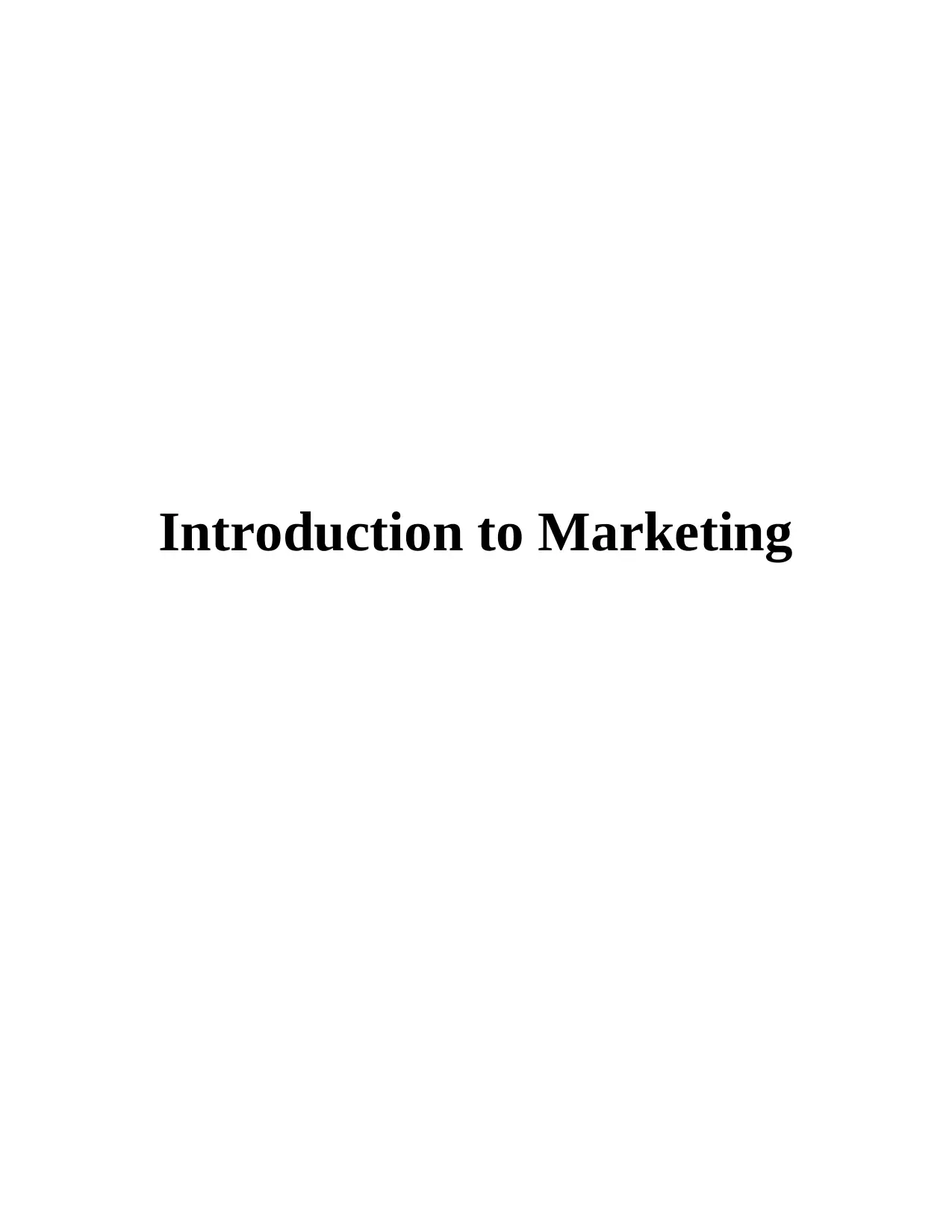
Introduction to Marketing
Paraphrase This Document
Need a fresh take? Get an instant paraphrase of this document with our AI Paraphraser

Table of Contents
INTRODUCTION...........................................................................................................................1
TASK 1............................................................................................................................................1
P1 Describe how marketing techniques are used to market products in two organisations.......1
P2 Describe the limitations and constraints of marketing...........................................................2
TASK 2............................................................................................................................................3
P3 How a selected organisation uses marketing research to contribute to the development.....3
P4 Use marketing research for marketing planning ...................................................................4
TASK 3............................................................................................................................................5
P5 Explain how and why groups of customers are targeted for selected products.....................5
TASK 4............................................................................................................................................5
P6 Develop a coherent marketing mix for a new product or service..........................................5
CONCLUSION................................................................................................................................6
REFERENCES................................................................................................................................7
INTRODUCTION...........................................................................................................................1
TASK 1............................................................................................................................................1
P1 Describe how marketing techniques are used to market products in two organisations.......1
P2 Describe the limitations and constraints of marketing...........................................................2
TASK 2............................................................................................................................................3
P3 How a selected organisation uses marketing research to contribute to the development.....3
P4 Use marketing research for marketing planning ...................................................................4
TASK 3............................................................................................................................................5
P5 Explain how and why groups of customers are targeted for selected products.....................5
TASK 4............................................................................................................................................5
P6 Develop a coherent marketing mix for a new product or service..........................................5
CONCLUSION................................................................................................................................6
REFERENCES................................................................................................................................7
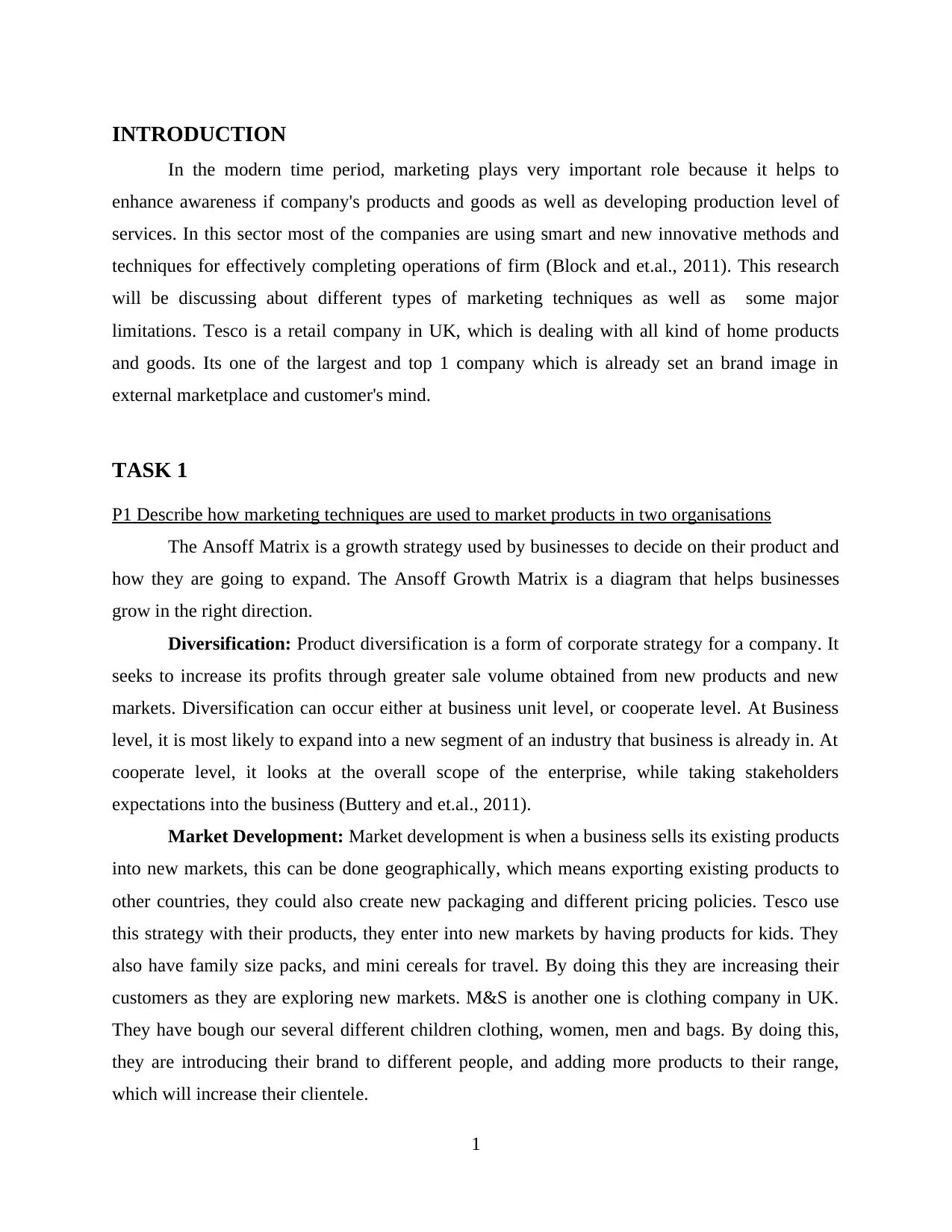
INTRODUCTION
In the modern time period, marketing plays very important role because it helps to
enhance awareness if company's products and goods as well as developing production level of
services. In this sector most of the companies are using smart and new innovative methods and
techniques for effectively completing operations of firm (Block and et.al., 2011). This research
will be discussing about different types of marketing techniques as well as some major
limitations. Tesco is a retail company in UK, which is dealing with all kind of home products
and goods. Its one of the largest and top 1 company which is already set an brand image in
external marketplace and customer's mind.
TASK 1
P1 Describe how marketing techniques are used to market products in two organisations
The Ansoff Matrix is a growth strategy used by businesses to decide on their product and
how they are going to expand. The Ansoff Growth Matrix is a diagram that helps businesses
grow in the right direction.
Diversification: Product diversification is a form of corporate strategy for a company. It
seeks to increase its profits through greater sale volume obtained from new products and new
markets. Diversification can occur either at business unit level, or cooperate level. At Business
level, it is most likely to expand into a new segment of an industry that business is already in. At
cooperate level, it looks at the overall scope of the enterprise, while taking stakeholders
expectations into the business (Buttery and et.al., 2011).
Market Development: Market development is when a business sells its existing products
into new markets, this can be done geographically, which means exporting existing products to
other countries, they could also create new packaging and different pricing policies. Tesco use
this strategy with their products, they enter into new markets by having products for kids. They
also have family size packs, and mini cereals for travel. By doing this they are increasing their
customers as they are exploring new markets. M&S is another one is clothing company in UK.
They have bough our several different children clothing, women, men and bags. By doing this,
they are introducing their brand to different people, and adding more products to their range,
which will increase their clientele.
1
In the modern time period, marketing plays very important role because it helps to
enhance awareness if company's products and goods as well as developing production level of
services. In this sector most of the companies are using smart and new innovative methods and
techniques for effectively completing operations of firm (Block and et.al., 2011). This research
will be discussing about different types of marketing techniques as well as some major
limitations. Tesco is a retail company in UK, which is dealing with all kind of home products
and goods. Its one of the largest and top 1 company which is already set an brand image in
external marketplace and customer's mind.
TASK 1
P1 Describe how marketing techniques are used to market products in two organisations
The Ansoff Matrix is a growth strategy used by businesses to decide on their product and
how they are going to expand. The Ansoff Growth Matrix is a diagram that helps businesses
grow in the right direction.
Diversification: Product diversification is a form of corporate strategy for a company. It
seeks to increase its profits through greater sale volume obtained from new products and new
markets. Diversification can occur either at business unit level, or cooperate level. At Business
level, it is most likely to expand into a new segment of an industry that business is already in. At
cooperate level, it looks at the overall scope of the enterprise, while taking stakeholders
expectations into the business (Buttery and et.al., 2011).
Market Development: Market development is when a business sells its existing products
into new markets, this can be done geographically, which means exporting existing products to
other countries, they could also create new packaging and different pricing policies. Tesco use
this strategy with their products, they enter into new markets by having products for kids. They
also have family size packs, and mini cereals for travel. By doing this they are increasing their
customers as they are exploring new markets. M&S is another one is clothing company in UK.
They have bough our several different children clothing, women, men and bags. By doing this,
they are introducing their brand to different people, and adding more products to their range,
which will increase their clientele.
1
⊘ This is a preview!⊘
Do you want full access?
Subscribe today to unlock all pages.

Trusted by 1+ million students worldwide
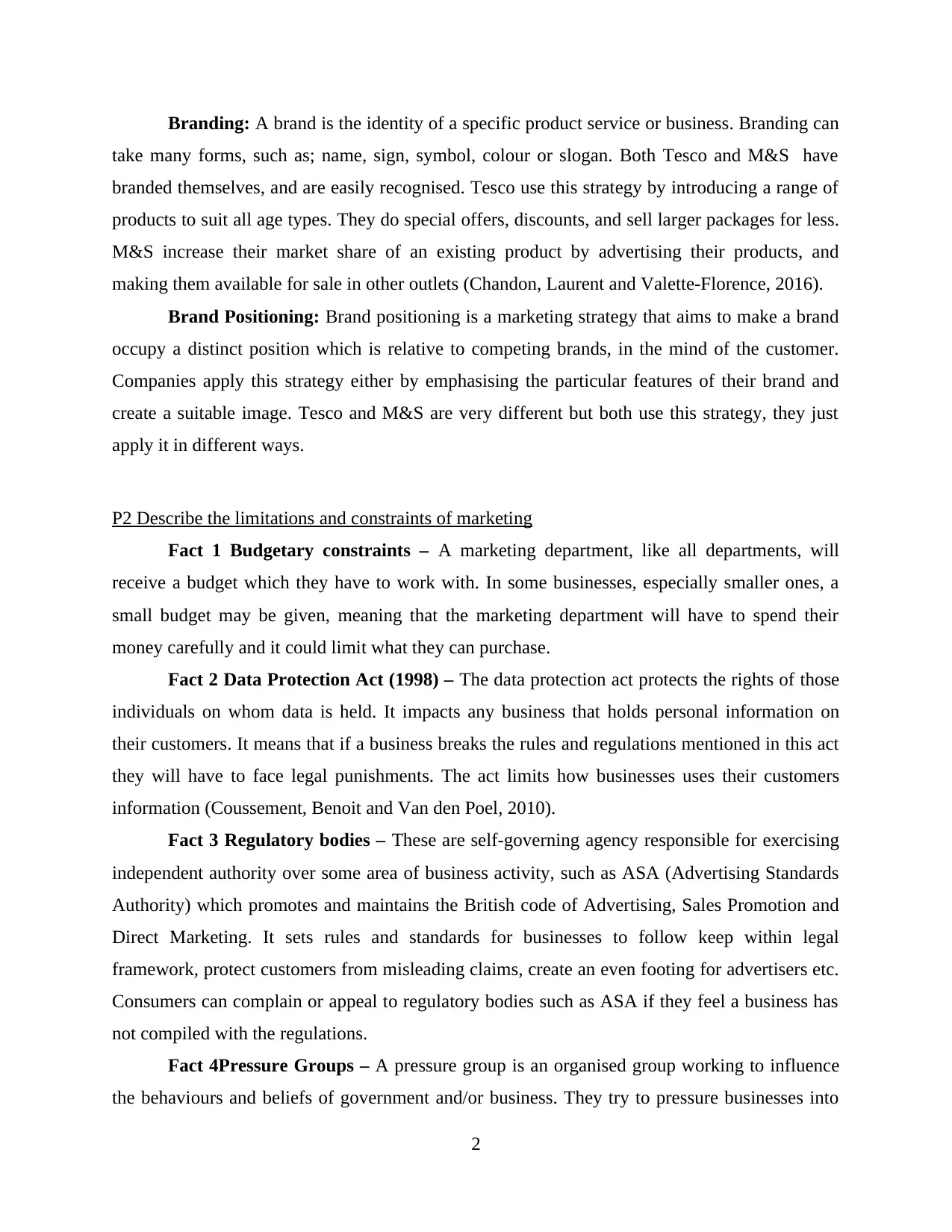
Branding: A brand is the identity of a specific product service or business. Branding can
take many forms, such as; name, sign, symbol, colour or slogan. Both Tesco and M&S have
branded themselves, and are easily recognised. Tesco use this strategy by introducing a range of
products to suit all age types. They do special offers, discounts, and sell larger packages for less.
M&S increase their market share of an existing product by advertising their products, and
making them available for sale in other outlets (Chandon, Laurent and Valette-Florence, 2016).
Brand Positioning: Brand positioning is a marketing strategy that aims to make a brand
occupy a distinct position which is relative to competing brands, in the mind of the customer.
Companies apply this strategy either by emphasising the particular features of their brand and
create a suitable image. Tesco and M&S are very different but both use this strategy, they just
apply it in different ways.
P2 Describe the limitations and constraints of marketing
Fact 1 Budgetary constraints – A marketing department, like all departments, will
receive a budget which they have to work with. In some businesses, especially smaller ones, a
small budget may be given, meaning that the marketing department will have to spend their
money carefully and it could limit what they can purchase.
Fact 2 Data Protection Act (1998) – The data protection act protects the rights of those
individuals on whom data is held. It impacts any business that holds personal information on
their customers. It means that if a business breaks the rules and regulations mentioned in this act
they will have to face legal punishments. The act limits how businesses uses their customers
information (Coussement, Benoit and Van den Poel, 2010).
Fact 3 Regulatory bodies – These are self-governing agency responsible for exercising
independent authority over some area of business activity, such as ASA (Advertising Standards
Authority) which promotes and maintains the British code of Advertising, Sales Promotion and
Direct Marketing. It sets rules and standards for businesses to follow keep within legal
framework, protect customers from misleading claims, create an even footing for advertisers etc.
Consumers can complain or appeal to regulatory bodies such as ASA if they feel a business has
not compiled with the regulations.
Fact 4Pressure Groups – A pressure group is an organised group working to influence
the behaviours and beliefs of government and/or business. They try to pressure businesses into
2
take many forms, such as; name, sign, symbol, colour or slogan. Both Tesco and M&S have
branded themselves, and are easily recognised. Tesco use this strategy by introducing a range of
products to suit all age types. They do special offers, discounts, and sell larger packages for less.
M&S increase their market share of an existing product by advertising their products, and
making them available for sale in other outlets (Chandon, Laurent and Valette-Florence, 2016).
Brand Positioning: Brand positioning is a marketing strategy that aims to make a brand
occupy a distinct position which is relative to competing brands, in the mind of the customer.
Companies apply this strategy either by emphasising the particular features of their brand and
create a suitable image. Tesco and M&S are very different but both use this strategy, they just
apply it in different ways.
P2 Describe the limitations and constraints of marketing
Fact 1 Budgetary constraints – A marketing department, like all departments, will
receive a budget which they have to work with. In some businesses, especially smaller ones, a
small budget may be given, meaning that the marketing department will have to spend their
money carefully and it could limit what they can purchase.
Fact 2 Data Protection Act (1998) – The data protection act protects the rights of those
individuals on whom data is held. It impacts any business that holds personal information on
their customers. It means that if a business breaks the rules and regulations mentioned in this act
they will have to face legal punishments. The act limits how businesses uses their customers
information (Coussement, Benoit and Van den Poel, 2010).
Fact 3 Regulatory bodies – These are self-governing agency responsible for exercising
independent authority over some area of business activity, such as ASA (Advertising Standards
Authority) which promotes and maintains the British code of Advertising, Sales Promotion and
Direct Marketing. It sets rules and standards for businesses to follow keep within legal
framework, protect customers from misleading claims, create an even footing for advertisers etc.
Consumers can complain or appeal to regulatory bodies such as ASA if they feel a business has
not compiled with the regulations.
Fact 4Pressure Groups – A pressure group is an organised group working to influence
the behaviours and beliefs of government and/or business. They try to pressure businesses into
2
Paraphrase This Document
Need a fresh take? Get an instant paraphrase of this document with our AI Paraphraser
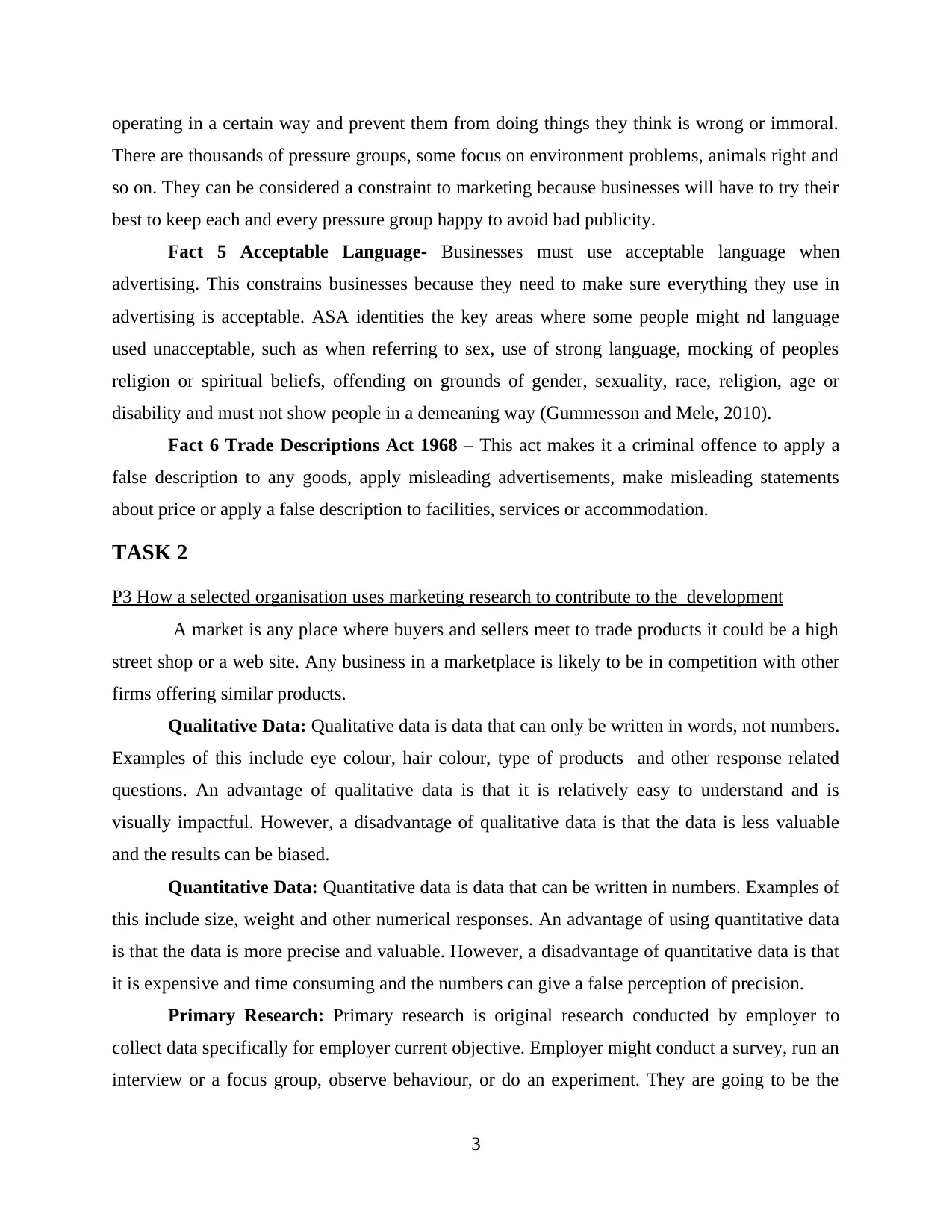
operating in a certain way and prevent them from doing things they think is wrong or immoral.
There are thousands of pressure groups, some focus on environment problems, animals right and
so on. They can be considered a constraint to marketing because businesses will have to try their
best to keep each and every pressure group happy to avoid bad publicity.
Fact 5 Acceptable Language- Businesses must use acceptable language when
advertising. This constrains businesses because they need to make sure everything they use in
advertising is acceptable. ASA identities the key areas where some people might nd language
used unacceptable, such as when referring to sex, use of strong language, mocking of peoples
religion or spiritual beliefs, offending on grounds of gender, sexuality, race, religion, age or
disability and must not show people in a demeaning way (Gummesson and Mele, 2010).
Fact 6 Trade Descriptions Act 1968 – This act makes it a criminal offence to apply a
false description to any goods, apply misleading advertisements, make misleading statements
about price or apply a false description to facilities, services or accommodation.
TASK 2
P3 How a selected organisation uses marketing research to contribute to the development
A market is any place where buyers and sellers meet to trade products it could be a high
street shop or a web site. Any business in a marketplace is likely to be in competition with other
firms offering similar products.
Qualitative Data: Qualitative data is data that can only be written in words, not numbers.
Examples of this include eye colour, hair colour, type of products and other response related
questions. An advantage of qualitative data is that it is relatively easy to understand and is
visually impactful. However, a disadvantage of qualitative data is that the data is less valuable
and the results can be biased.
Quantitative Data: Quantitative data is data that can be written in numbers. Examples of
this include size, weight and other numerical responses. An advantage of using quantitative data
is that the data is more precise and valuable. However, a disadvantage of quantitative data is that
it is expensive and time consuming and the numbers can give a false perception of precision.
Primary Research: Primary research is original research conducted by employer to
collect data specifically for employer current objective. Employer might conduct a survey, run an
interview or a focus group, observe behaviour, or do an experiment. They are going to be the
3
There are thousands of pressure groups, some focus on environment problems, animals right and
so on. They can be considered a constraint to marketing because businesses will have to try their
best to keep each and every pressure group happy to avoid bad publicity.
Fact 5 Acceptable Language- Businesses must use acceptable language when
advertising. This constrains businesses because they need to make sure everything they use in
advertising is acceptable. ASA identities the key areas where some people might nd language
used unacceptable, such as when referring to sex, use of strong language, mocking of peoples
religion or spiritual beliefs, offending on grounds of gender, sexuality, race, religion, age or
disability and must not show people in a demeaning way (Gummesson and Mele, 2010).
Fact 6 Trade Descriptions Act 1968 – This act makes it a criminal offence to apply a
false description to any goods, apply misleading advertisements, make misleading statements
about price or apply a false description to facilities, services or accommodation.
TASK 2
P3 How a selected organisation uses marketing research to contribute to the development
A market is any place where buyers and sellers meet to trade products it could be a high
street shop or a web site. Any business in a marketplace is likely to be in competition with other
firms offering similar products.
Qualitative Data: Qualitative data is data that can only be written in words, not numbers.
Examples of this include eye colour, hair colour, type of products and other response related
questions. An advantage of qualitative data is that it is relatively easy to understand and is
visually impactful. However, a disadvantage of qualitative data is that the data is less valuable
and the results can be biased.
Quantitative Data: Quantitative data is data that can be written in numbers. Examples of
this include size, weight and other numerical responses. An advantage of using quantitative data
is that the data is more precise and valuable. However, a disadvantage of quantitative data is that
it is expensive and time consuming and the numbers can give a false perception of precision.
Primary Research: Primary research is original research conducted by employer to
collect data specifically for employer current objective. Employer might conduct a survey, run an
interview or a focus group, observe behaviour, or do an experiment. They are going to be the
3
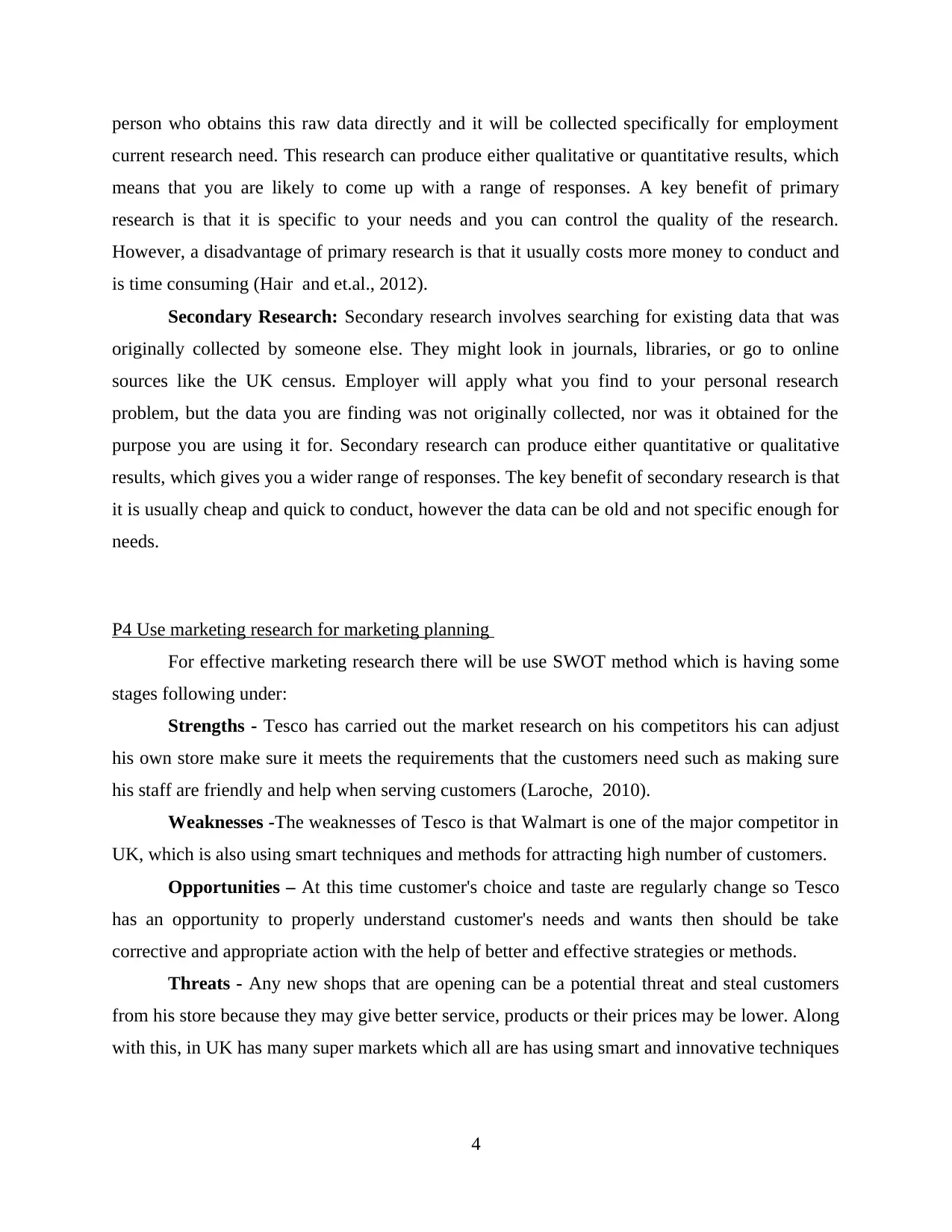
person who obtains this raw data directly and it will be collected specifically for employment
current research need. This research can produce either qualitative or quantitative results, which
means that you are likely to come up with a range of responses. A key benefit of primary
research is that it is specific to your needs and you can control the quality of the research.
However, a disadvantage of primary research is that it usually costs more money to conduct and
is time consuming (Hair and et.al., 2012).
Secondary Research: Secondary research involves searching for existing data that was
originally collected by someone else. They might look in journals, libraries, or go to online
sources like the UK census. Employer will apply what you find to your personal research
problem, but the data you are finding was not originally collected, nor was it obtained for the
purpose you are using it for. Secondary research can produce either quantitative or qualitative
results, which gives you a wider range of responses. The key benefit of secondary research is that
it is usually cheap and quick to conduct, however the data can be old and not specific enough for
needs.
P4 Use marketing research for marketing planning
For effective marketing research there will be use SWOT method which is having some
stages following under:
Strengths - Tesco has carried out the market research on his competitors his can adjust
his own store make sure it meets the requirements that the customers need such as making sure
his staff are friendly and help when serving customers (Laroche, 2010).
Weaknesses -The weaknesses of Tesco is that Walmart is one of the major competitor in
UK, which is also using smart techniques and methods for attracting high number of customers.
Opportunities – At this time customer's choice and taste are regularly change so Tesco
has an opportunity to properly understand customer's needs and wants then should be take
corrective and appropriate action with the help of better and effective strategies or methods.
Threats - Any new shops that are opening can be a potential threat and steal customers
from his store because they may give better service, products or their prices may be lower. Along
with this, in UK has many super markets which all are has using smart and innovative techniques
4
current research need. This research can produce either qualitative or quantitative results, which
means that you are likely to come up with a range of responses. A key benefit of primary
research is that it is specific to your needs and you can control the quality of the research.
However, a disadvantage of primary research is that it usually costs more money to conduct and
is time consuming (Hair and et.al., 2012).
Secondary Research: Secondary research involves searching for existing data that was
originally collected by someone else. They might look in journals, libraries, or go to online
sources like the UK census. Employer will apply what you find to your personal research
problem, but the data you are finding was not originally collected, nor was it obtained for the
purpose you are using it for. Secondary research can produce either quantitative or qualitative
results, which gives you a wider range of responses. The key benefit of secondary research is that
it is usually cheap and quick to conduct, however the data can be old and not specific enough for
needs.
P4 Use marketing research for marketing planning
For effective marketing research there will be use SWOT method which is having some
stages following under:
Strengths - Tesco has carried out the market research on his competitors his can adjust
his own store make sure it meets the requirements that the customers need such as making sure
his staff are friendly and help when serving customers (Laroche, 2010).
Weaknesses -The weaknesses of Tesco is that Walmart is one of the major competitor in
UK, which is also using smart techniques and methods for attracting high number of customers.
Opportunities – At this time customer's choice and taste are regularly change so Tesco
has an opportunity to properly understand customer's needs and wants then should be take
corrective and appropriate action with the help of better and effective strategies or methods.
Threats - Any new shops that are opening can be a potential threat and steal customers
from his store because they may give better service, products or their prices may be lower. Along
with this, in UK has many super markets which all are has using smart and innovative techniques
4
⊘ This is a preview!⊘
Do you want full access?
Subscribe today to unlock all pages.

Trusted by 1+ million students worldwide
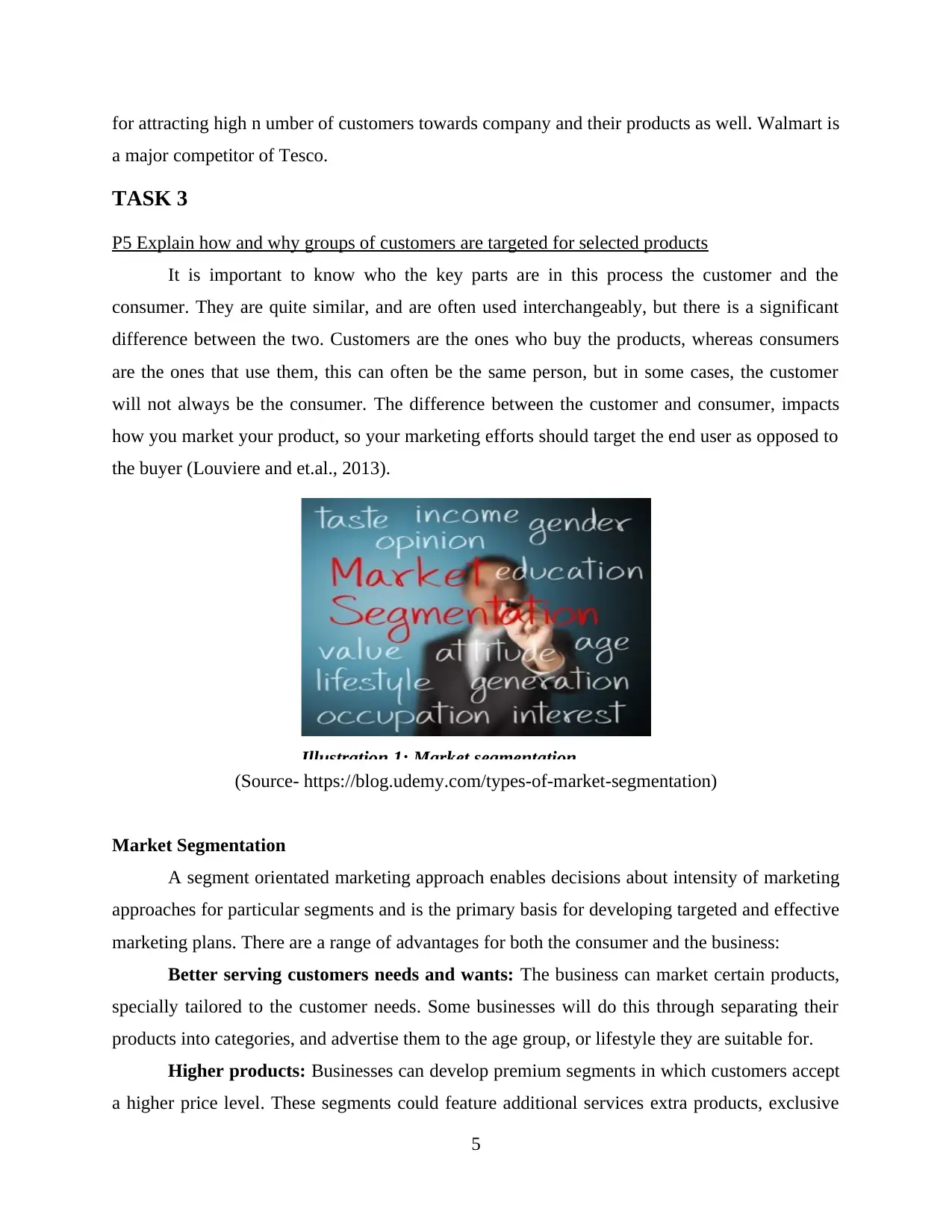
for attracting high n umber of customers towards company and their products as well. Walmart is
a major competitor of Tesco.
TASK 3
P5 Explain how and why groups of customers are targeted for selected products
It is important to know who the key parts are in this process the customer and the
consumer. They are quite similar, and are often used interchangeably, but there is a significant
difference between the two. Customers are the ones who buy the products, whereas consumers
are the ones that use them, this can often be the same person, but in some cases, the customer
will not always be the consumer. The difference between the customer and consumer, impacts
how you market your product, so your marketing efforts should target the end user as opposed to
the buyer (Louviere and et.al., 2013).
Illustration 1: Market segmentation
(Source- https://blog.udemy.com/types-of-market-segmentation)
Market Segmentation
A segment orientated marketing approach enables decisions about intensity of marketing
approaches for particular segments and is the primary basis for developing targeted and effective
marketing plans. There are a range of advantages for both the consumer and the business:
Better serving customers needs and wants: The business can market certain products,
specially tailored to the customer needs. Some businesses will do this through separating their
products into categories, and advertise them to the age group, or lifestyle they are suitable for.
Higher products: Businesses can develop premium segments in which customers accept
a higher price level. These segments could feature additional services extra products, exclusive
5
a major competitor of Tesco.
TASK 3
P5 Explain how and why groups of customers are targeted for selected products
It is important to know who the key parts are in this process the customer and the
consumer. They are quite similar, and are often used interchangeably, but there is a significant
difference between the two. Customers are the ones who buy the products, whereas consumers
are the ones that use them, this can often be the same person, but in some cases, the customer
will not always be the consumer. The difference between the customer and consumer, impacts
how you market your product, so your marketing efforts should target the end user as opposed to
the buyer (Louviere and et.al., 2013).
Illustration 1: Market segmentation
(Source- https://blog.udemy.com/types-of-market-segmentation)
Market Segmentation
A segment orientated marketing approach enables decisions about intensity of marketing
approaches for particular segments and is the primary basis for developing targeted and effective
marketing plans. There are a range of advantages for both the consumer and the business:
Better serving customers needs and wants: The business can market certain products,
specially tailored to the customer needs. Some businesses will do this through separating their
products into categories, and advertise them to the age group, or lifestyle they are suitable for.
Higher products: Businesses can develop premium segments in which customers accept
a higher price level. These segments could feature additional services extra products, exclusive
5
Paraphrase This Document
Need a fresh take? Get an instant paraphrase of this document with our AI Paraphraser
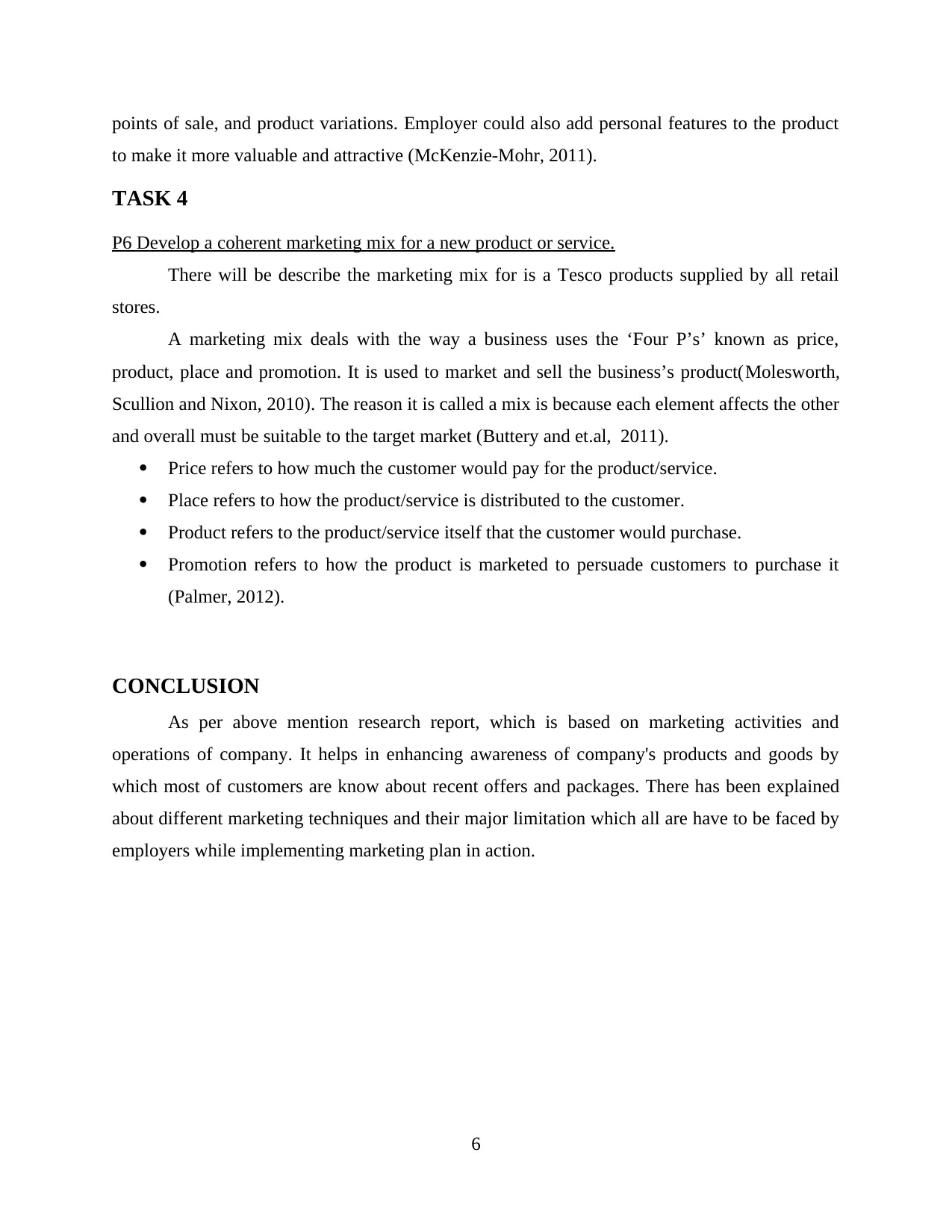
points of sale, and product variations. Employer could also add personal features to the product
to make it more valuable and attractive (McKenzie-Mohr, 2011).
TASK 4
P6 Develop a coherent marketing mix for a new product or service.
There will be describe the marketing mix for is a Tesco products supplied by all retail
stores.
A marketing mix deals with the way a business uses the ‘Four P’s’ known as price,
product, place and promotion. It is used to market and sell the business’s product(Molesworth,
Scullion and Nixon, 2010). The reason it is called a mix is because each element affects the other
and overall must be suitable to the target market (Buttery and et.al, 2011).
Price refers to how much the customer would pay for the product/service.
Place refers to how the product/service is distributed to the customer.
Product refers to the product/service itself that the customer would purchase.
Promotion refers to how the product is marketed to persuade customers to purchase it
(Palmer, 2012).
CONCLUSION
As per above mention research report, which is based on marketing activities and
operations of company. It helps in enhancing awareness of company's products and goods by
which most of customers are know about recent offers and packages. There has been explained
about different marketing techniques and their major limitation which all are have to be faced by
employers while implementing marketing plan in action.
6
to make it more valuable and attractive (McKenzie-Mohr, 2011).
TASK 4
P6 Develop a coherent marketing mix for a new product or service.
There will be describe the marketing mix for is a Tesco products supplied by all retail
stores.
A marketing mix deals with the way a business uses the ‘Four P’s’ known as price,
product, place and promotion. It is used to market and sell the business’s product(Molesworth,
Scullion and Nixon, 2010). The reason it is called a mix is because each element affects the other
and overall must be suitable to the target market (Buttery and et.al, 2011).
Price refers to how much the customer would pay for the product/service.
Place refers to how the product/service is distributed to the customer.
Product refers to the product/service itself that the customer would purchase.
Promotion refers to how the product is marketed to persuade customers to purchase it
(Palmer, 2012).
CONCLUSION
As per above mention research report, which is based on marketing activities and
operations of company. It helps in enhancing awareness of company's products and goods by
which most of customers are know about recent offers and packages. There has been explained
about different marketing techniques and their major limitation which all are have to be faced by
employers while implementing marketing plan in action.
6
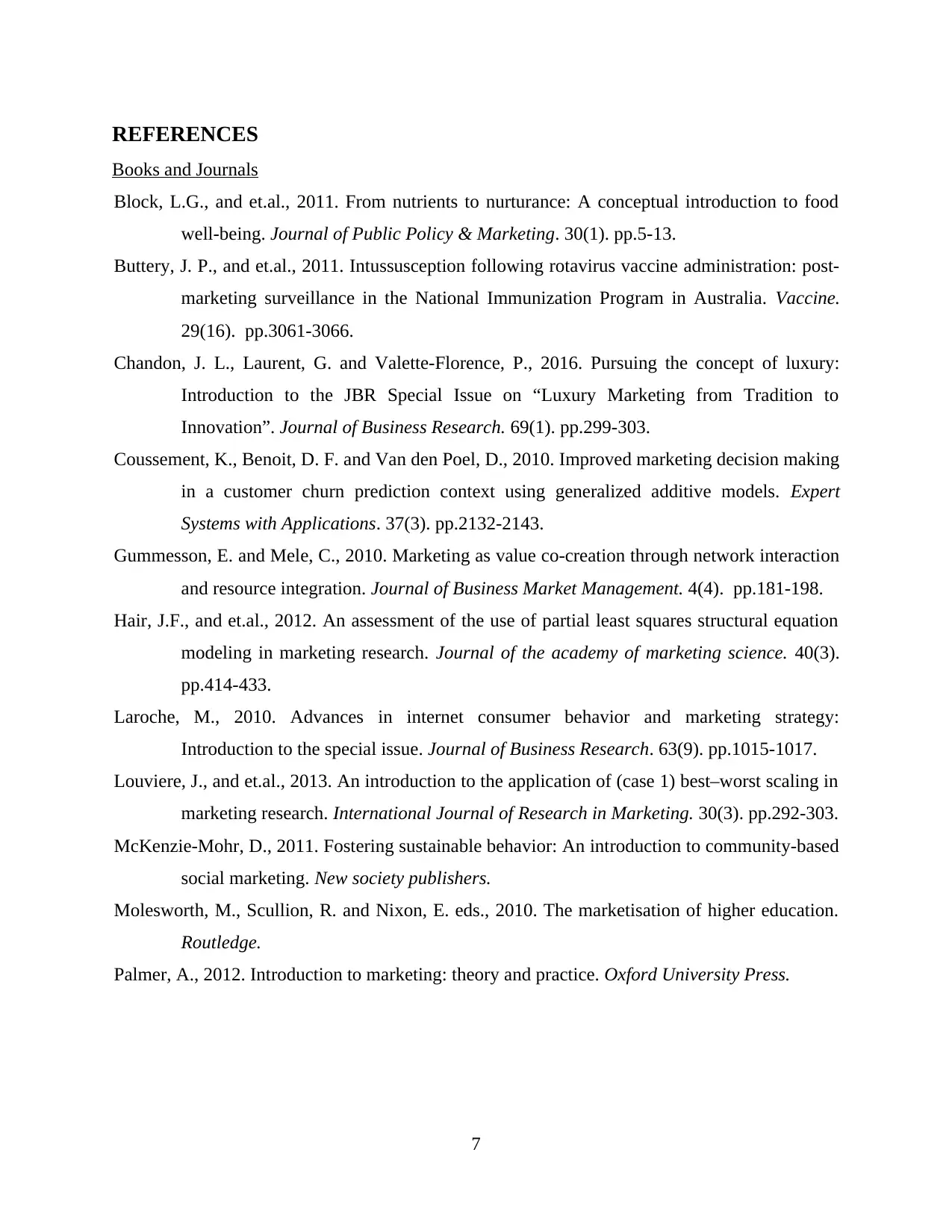
REFERENCES
Books and Journals
Block, L.G., and et.al., 2011. From nutrients to nurturance: A conceptual introduction to food
well-being. Journal of Public Policy & Marketing. 30(1). pp.5-13.
Buttery, J. P., and et.al., 2011. Intussusception following rotavirus vaccine administration: post-
marketing surveillance in the National Immunization Program in Australia. Vaccine.
29(16). pp.3061-3066.
Chandon, J. L., Laurent, G. and Valette-Florence, P., 2016. Pursuing the concept of luxury:
Introduction to the JBR Special Issue on “Luxury Marketing from Tradition to
Innovation”. Journal of Business Research. 69(1). pp.299-303.
Coussement, K., Benoit, D. F. and Van den Poel, D., 2010. Improved marketing decision making
in a customer churn prediction context using generalized additive models. Expert
Systems with Applications. 37(3). pp.2132-2143.
Gummesson, E. and Mele, C., 2010. Marketing as value co-creation through network interaction
and resource integration. Journal of Business Market Management. 4(4). pp.181-198.
Hair, J.F., and et.al., 2012. An assessment of the use of partial least squares structural equation
modeling in marketing research. Journal of the academy of marketing science. 40(3).
pp.414-433.
Laroche, M., 2010. Advances in internet consumer behavior and marketing strategy:
Introduction to the special issue. Journal of Business Research. 63(9). pp.1015-1017.
Louviere, J., and et.al., 2013. An introduction to the application of (case 1) best–worst scaling in
marketing research. International Journal of Research in Marketing. 30(3). pp.292-303.
McKenzie-Mohr, D., 2011. Fostering sustainable behavior: An introduction to community-based
social marketing. New society publishers.
Molesworth, M., Scullion, R. and Nixon, E. eds., 2010. The marketisation of higher education.
Routledge.
Palmer, A., 2012. Introduction to marketing: theory and practice. Oxford University Press.
7
Books and Journals
Block, L.G., and et.al., 2011. From nutrients to nurturance: A conceptual introduction to food
well-being. Journal of Public Policy & Marketing. 30(1). pp.5-13.
Buttery, J. P., and et.al., 2011. Intussusception following rotavirus vaccine administration: post-
marketing surveillance in the National Immunization Program in Australia. Vaccine.
29(16). pp.3061-3066.
Chandon, J. L., Laurent, G. and Valette-Florence, P., 2016. Pursuing the concept of luxury:
Introduction to the JBR Special Issue on “Luxury Marketing from Tradition to
Innovation”. Journal of Business Research. 69(1). pp.299-303.
Coussement, K., Benoit, D. F. and Van den Poel, D., 2010. Improved marketing decision making
in a customer churn prediction context using generalized additive models. Expert
Systems with Applications. 37(3). pp.2132-2143.
Gummesson, E. and Mele, C., 2010. Marketing as value co-creation through network interaction
and resource integration. Journal of Business Market Management. 4(4). pp.181-198.
Hair, J.F., and et.al., 2012. An assessment of the use of partial least squares structural equation
modeling in marketing research. Journal of the academy of marketing science. 40(3).
pp.414-433.
Laroche, M., 2010. Advances in internet consumer behavior and marketing strategy:
Introduction to the special issue. Journal of Business Research. 63(9). pp.1015-1017.
Louviere, J., and et.al., 2013. An introduction to the application of (case 1) best–worst scaling in
marketing research. International Journal of Research in Marketing. 30(3). pp.292-303.
McKenzie-Mohr, D., 2011. Fostering sustainable behavior: An introduction to community-based
social marketing. New society publishers.
Molesworth, M., Scullion, R. and Nixon, E. eds., 2010. The marketisation of higher education.
Routledge.
Palmer, A., 2012. Introduction to marketing: theory and practice. Oxford University Press.
7
⊘ This is a preview!⊘
Do you want full access?
Subscribe today to unlock all pages.

Trusted by 1+ million students worldwide
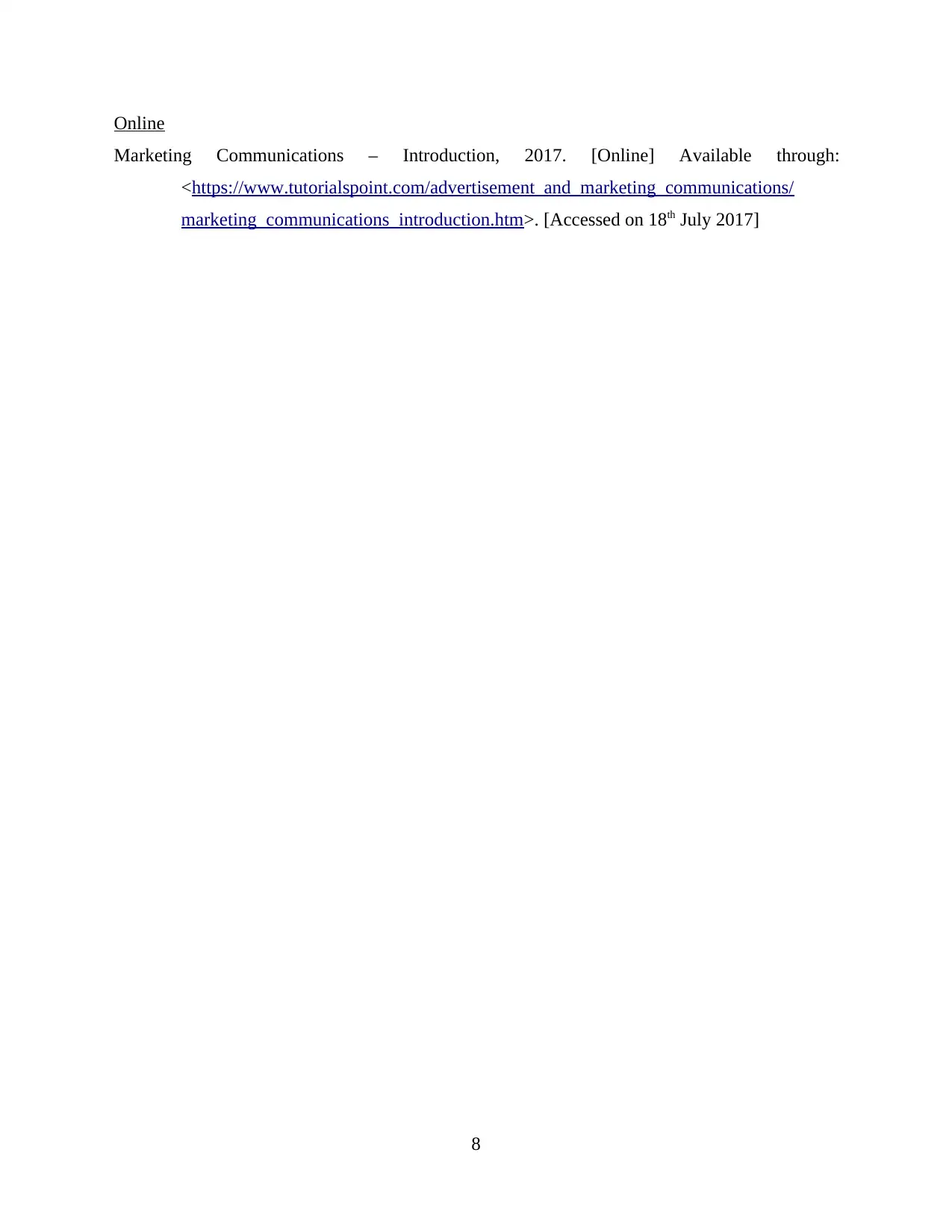
Online
Marketing Communications – Introduction, 2017. [Online] Available through:
<https://www.tutorialspoint.com/advertisement_and_marketing_communications/
marketing_communications_introduction.htm>. [Accessed on 18th July 2017]
8
Marketing Communications – Introduction, 2017. [Online] Available through:
<https://www.tutorialspoint.com/advertisement_and_marketing_communications/
marketing_communications_introduction.htm>. [Accessed on 18th July 2017]
8
1 out of 10
Related Documents
Your All-in-One AI-Powered Toolkit for Academic Success.
+13062052269
info@desklib.com
Available 24*7 on WhatsApp / Email
![[object Object]](/_next/static/media/star-bottom.7253800d.svg)
Unlock your academic potential
Copyright © 2020–2025 A2Z Services. All Rights Reserved. Developed and managed by ZUCOL.





